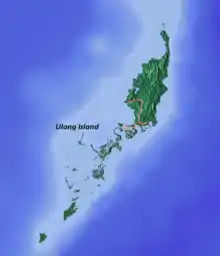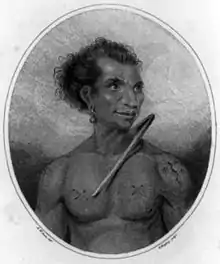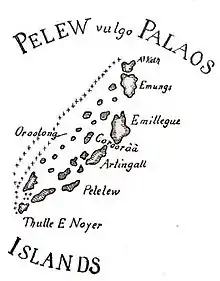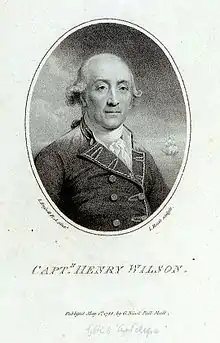Henry Wilson (sailor)
Henry Wilson (1740–1810)[1][2] was an English naval captain of the British East India Company, from Rotherhithe.[3] He was in command of the British East India Company packet ship Antelope, when it shipwrecked off Ulong Island,[4] near Koror Island in Palau in 1783, and the East Indiaman Warley at the Battle of Pulo Aura.

Voyage of 1783
The context was the Fourth Anglo-Dutch War; normal routes from China westwards for British shipping were hampered by the Dutch East Indies. The Antelope had been returning from Macau by the "Eastern Passage", a route designed to avoid the south-west monsoon, but had strayed too far in the easterly direction.[5]
On the north coast of New Guinea Wilson anchored in the vicinity of the Schouten Islands. After some dialogue over two days with Papuan inhabitants who came out to the ship, in which Wilson used vocabulary collected by Thomas Forrest at Dory Harbour, Wilson felt the numbers he faced were threatening. He used small arms to deter them, and the crew of the Antelope was attacked, an encounter in which the artist Arthur William Devis was injured. The wreck on Ulong followed.[6][7]


Although Spain had claimed the islands previously, Wilson's crew made the first sustained contact, which was friendly. One of the crew of the Antelope knew Malay, allowing contact to be made with the ibedul on Koror, whom Wilson treated as a local king, somewhat misapprehending his status, which was more like an elected official. While his men spent three months rebuilding the ship, Wilson entered an effective alliance with the ibedul in conflicts with Melekeok and others. One of the Antelope's guns proved decisive, shipped in a boat and discharged with powder alone.[8]

Return to England
Prince Lee Boo from Palau returned to England with Wilson and lived with his family in Rotherhithe. Unfortunately, after a few months he died of smallpox in 1784.[9] Much interest in Palau followed. Wilson's collection of curiosities, that were exchanged with the ibedul and form the earliest known group of Palau artefacts, are held by the British Museum.[10][11][12][13] George Keate wrote an account of Wilson's experiences in 1788, a book heavily influenced by the current conceptions concerning the "noble savage".[14][15] The book became quite popular. "Between 1789 and 1850, more than 20 English and a dozen foreign-language editions were published in different countries."[16] The East India Company turned attention from Mindanao as a possible outpost to the New Guinea archipelago, and John McCluer went from Bombay to Palau in 1790 as hydrographer.[5]

Later life
Later Wilson was captain of the East Indiaman Warley for five voyages. He was captain in 1804 at the Battle of Pulo Aura when a fleet of East Indiamen under Nathaniel Dance fought and bluffed a French squadron. Wilson died on 10 May 1810 at his home in Colyton, Devon.[17][18]
References
- Nan Kivell Catalogue (PDF), at p. 74.
- pastellists.com (PDF)
- "portcities.org.uk". Archived from the original on 12 September 2012. Retrieved 20 October 2011.
- "Palau: Airai – Visitors: Explorers". Retrieved 25 December 2007.
- Howard Tyrrell Fry, Alexander Dalrymple (1737–1808) and the Expansion of British Trade (2006), p. 152; Google Books.
- Sudipta Sen, Distant sovereignty: national imperialism and the origins of British India (2002), p. 111; Google Books.
- Transactions of the Royal Asiatic Society of Great Britain and Ireland, Volume 3 (1835) p. 129 note;Google Books.
- Arnold H. Leibowitz (1 January 1996). Embattled Island: Palau's Struggle for Independence. Greenwood Publishing Group. pp. 10–. ISBN 978-0-275-95390-4.
- "Museum of London page". Archived from the original on 16 December 2010. Retrieved 20 October 2011.
- British Museum Collection
- British Museum Highlights
- British Museum Highlights
- British Museum Highlights
- . Dictionary of National Biography. London: Smith, Elder & Co. 1885–1900.
- Richard Lansdown, Strangers in the South Seas: the idea of the Pacific in Western thought: an anthology (2006), p. 99;Google Books.
- Keate, George. The Interesting History of Prince Lee Boo, Brought to England from the Pelew Islands. World Digital Library. Retrieved 27 March 2014.
- The European Magazine vol. 57 (1810), p. 472; Google Books.
- National Maritime Museum page
Further reading
- Henry Wilson (journal) and George Keate: Account of the Pelew Islands, situated in the western part of the Pacific Ocean. Nicol, Londres 1788; Pissot, Paris 1789 (in English!); G. Nicol, London 1879; Leicester University Press, 2001 ISBN 0-7185-0155-1
- in German: Nachrichten von den Pelew-Inseln, in der Westgegend des Stillen Oceans. transl. Georg Forster. Benjamin Gottlob Hoffmann, Hamburg 1789; Süddeutsche Zeitung, Munich 2007, Bibliotheca Anna Amalia, ISBN 3-86615-413-5
- Keate, George. The Interesting History of Prince Lee Boo, Brought to England from the Pelew Islands. World Digital Library. Retrieved 27 March 2014.